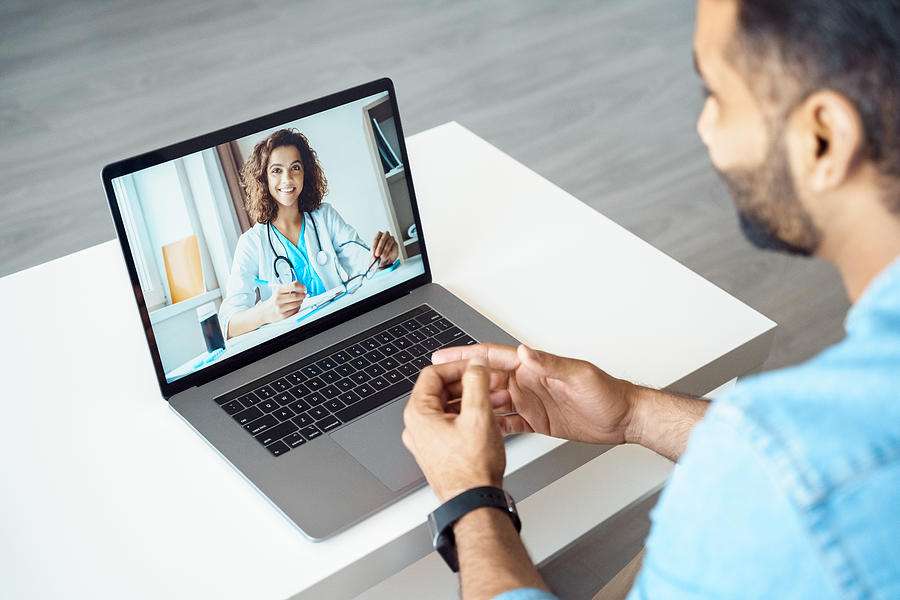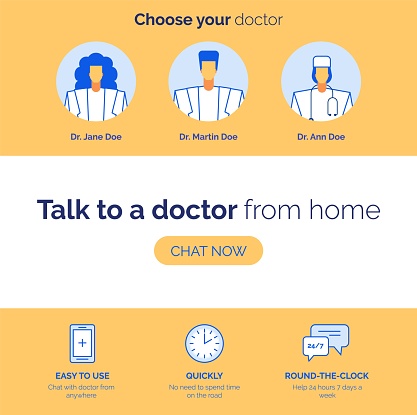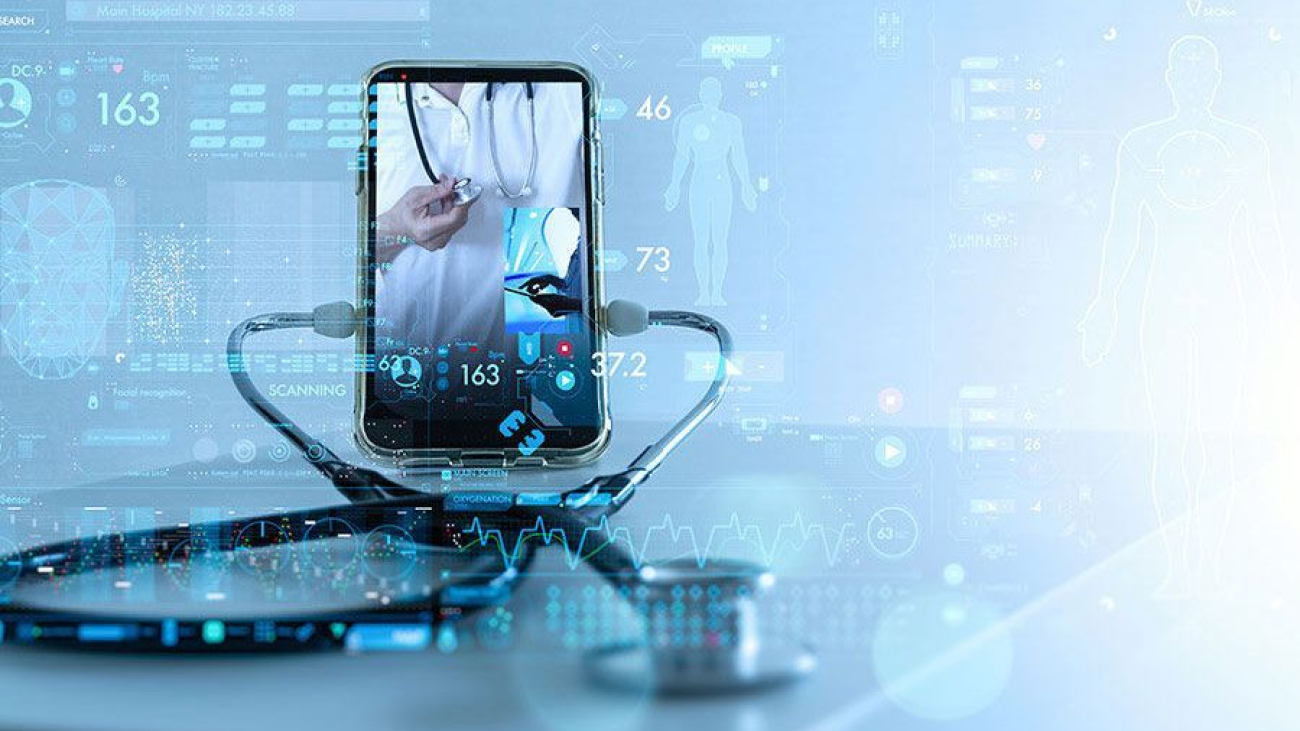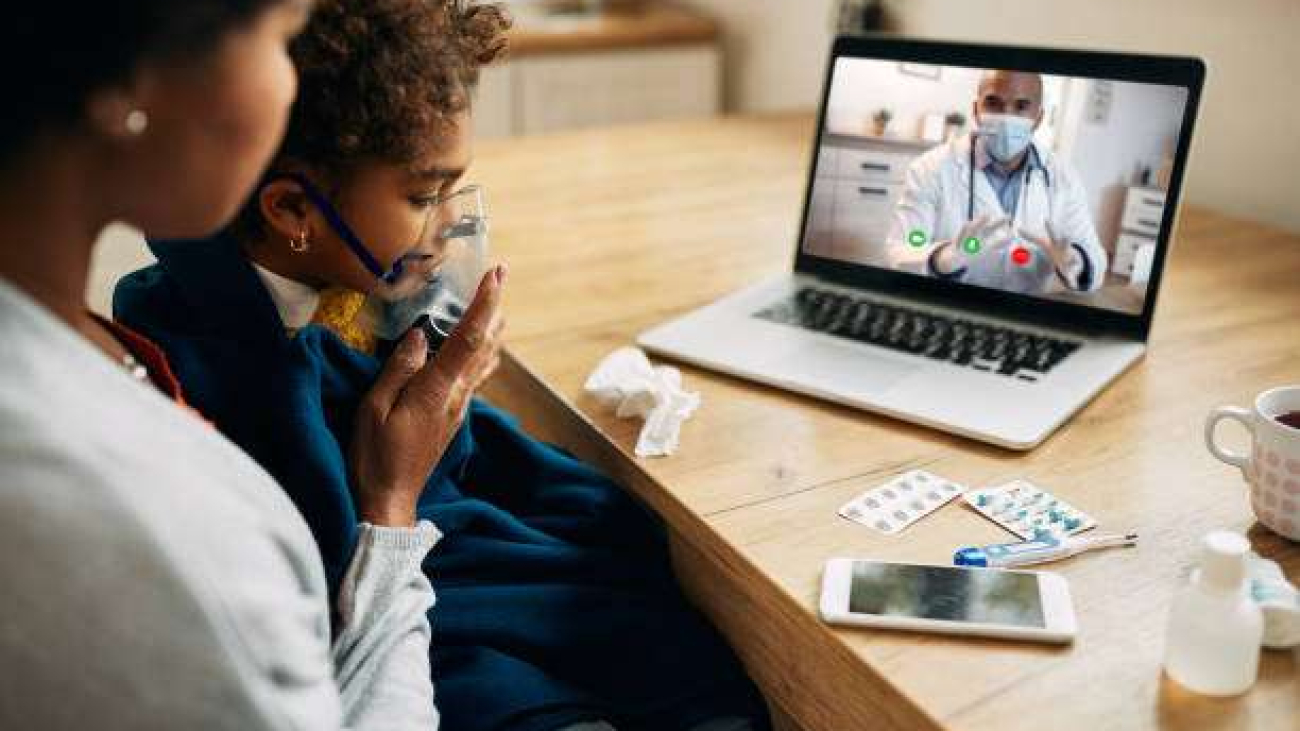In a world where healthcare costs are skyrocketing, affordable virtual healthcare options provide an essential lifeline for millions of people.
Navigating Stress: Your Telehealth Companion in Mental Well-being
Stress has become a common companion for many in this present world. At JEAY Healthcare, we understand the importance of mental well-being and the integral role telehealth plays in navigating stress. Join us as we explore the ways in which our Tele-medical services can be your ally in achieving a balanced and stress-free life.
The Impact of Stress:
Stress affects us all, impacting our physical and mental health. Recognizing the signs and finding effective coping mechanisms is crucial for maintaining overall well-being. Virtual consultations provide a secure space to discuss concerns with healthcare professionals, ensuring accessibility to mental health support.

Stress Management Strategies (Health Tips)
Mindfulness Practices: Incorporate mindfulness into your daily routine through activities like meditation or deep breathing exercises.
Self-Care Rituals: Prioritize self-care activities that bring joy and relaxation, whether it’s reading, spending time in nature, or enjoying a hobby.
Social Connection: Stay connected with friends and family, fostering a supportive network.
Healthy Lifestyle Choices: Maintain a balanced diet, engage in regular physical activity, and prioritize sufficient sleep to support overall health.
Time Management: Organize your schedule to include breaks, leisure activities, and adequate time for relaxation.
Setting Boundaries: Establish clear boundaries between work and personal life to maintain a healthy balance
Navigating Stress Together: We are committed to providing comprehensive support for your mental health. Through telehealth, we aim to break down barriers to accessing mental health resources, ensuring that you can navigate stress with confidence and resilience.
Exploring the Future of Telehealth: A JEAY Healthcare Insight
At JEAY Healthcare, we’re excited about the possibilities it brings. Let’s take a quick dive into what the future holds:
Convenience Meets Care: JEAY Healthcare Partners with Famasi Africa to Enhance Medical Services and Medication Delivery
In a world that never stops moving, finding a balance between convenience and care is a constant challenge. However, the healthcare industry is evolving to meet this demand, and the latest collaboration between JEAY Healthcare and Famasi Africa is a shining example of how convenience and care can coexist harmoniously.
JEAY Healthcare: Pioneering Virtual Medical Services
JEAY Healthcare has been a trailblazer in the realm of virtual medical services. By leveraging state-of-the-art technology, they have reimagined the traditional doctor’s visit, making healthcare more accessible and patient-centric. Through their secure telemedicine platform, patients can now schedule virtual consultations with experienced healthcare professionals from the comfort of their homes. No more long commutes, no more waiting rooms, just personalized medical care at your fingertips.
Famasi Africa: Revolutionizing Medication Delivery
Famasi Africa’s reputation as a reliable and efficient medication delivery service precedes them. Their dedication to ensuring patients receive their prescribed medications on time has garnered them the trust of countless individuals. By partnering with JEAY Healthcare, Famasi Africa takes their commitment to patient care one step further.
After a virtual medical consultation with JEAY Healthcare, patients can seamlessly access Famasi’s medication delivery services. This integration streamlines the process of getting essential medications, eliminating the need to visit a pharmacy in person. With Famasi’s robust network and secure delivery methods, patients can have peace of mind knowing their health needs are in safe hands.
To experience the convenience of virtual medical services and the care of reliable medication delivery, download our mobile app now on Playstore: Click here to download
Together, we are revolutionizing healthcare and empowering individuals to lead healthier, and happier lives.

Using Telehealth To Treat Dementia.
Telehealth is the use of information and communication technology to provide health services virtually or at a distance.
Its impact has no doubt been greatly felt across the entire medical sector. Especially during the pandemic when both patients and doctors were forced to find an alternative to their physical visits to curb the spread of the COVID virus
The virtual world played a huge role in getting healthcare to people in those times and has been in use since then. For patients with dementia, telemedicine came into the picture as well and we’ll be exploring how in this article.
What Is Dementia?
Dementia is a general term for conditions in which memory and other thinking skills deteriorate to the point that someone can no longer manage their daily activities without assistance. The conditions usually affect older people, but are not a sign of aging.
If the memory and thinking problems are milder, so that the patient living independently is not affected, the condition is described as mild cognitive impairment (MCI).
Dementia is an umbrella term for all forms of conditions associated with memory loss, the most common of them being Alhelzeimer’s disease.
Disorders grouped under the general term “dementia” are caused by abnormal brain changes or damage to the brain cells’ ability to communicate with each other.
The symptoms include:
● Cognitive changes like,
-
Memory loss, which is usually noticed by someone else.
-
Difficulty communicating or finding words.
-
Difficulty with visual and spatial abilities, such as getting lost while driving.
-
Difficulty reasoning or problem-solving.
-
Difficulty handling complex tasks.
-
Difficulty with planning and organizing. E.g. trouble handling money responsibly and paying bills.
-
Difficulty with coordination and motor functions. For example, losing balance and having problems with movement.
-
Confusion and disorientation.
● Psychological changes like,
- Personality changes.
Depression and losing interest in normal daily activities or events.
- Anxiety.
-
Inappropriate behavior.
-
Paranoia.
-
Agitation.
- Hallucinations.
It’s important to see a doctor if you or a loved one has memory problems or of these other dementia symptoms. Dementia symptoms can also be caused by some treatable medical conditions so it’s important to get a diagnosis.
Role of Telehealth In Treating Dementia.
Using live, two-way video interactions and other virtual tools, assessment, diagnosis, and treatment of dementia have been made easier. This is achieved with the following healthcare services;
- Thorough virtual clinical assessments.
This is important for the detection of dementia as well as for organizing or changing treatment plans.
- Full memory and cognitive evaluations conducted virtually.
- Diagnostic labs and imaging studies of the brain, such as CT scans or MRI, are conducted locally but can be sent and accessed remotely.
- Continuous monitoring of disease progression through Remote Patient Monitoring (RPM). This is effective in preventing crises or emergency situations.
- Constant communication with primary care doctors to determine the best treatment options, regardless of location.
- Virtual education, support, and other resources for family members caring for dementia patients.
- Remote training and professional development for dementia care teams.
This helps them stay current on best practices while remaining in the clinic and available to patients.
- Home monitoring of persons living alone who have mild dementia.
Senior citizens with dementia living alone tend to forget to make appointments, talk more of attending them. With telehealth, they have a better chance at treatment and management through Remote Patient Monitoring.
- Interdisciplinary care.
With telehealth, it’s no longer just a linear patient-physician relationship. But care now involves other medical professionals, thereby lessening the burden on primary caregivers.
Benefits Of Telehealth For Older Adults.
● Accessibility.
Since dementia patients are elderly, hospital visits usually require a third party’s help and are usually a lot of hassle. The care providers on the other hand are not so readily available. But with telehealth, the patient and physician rift has been bridged with the concept of virtual care.
● Better outcomes.
As telehealth encourages collusion between the care team and interdisciplinary care, healthcare providers are able to construct or modify better treatment plans for dementia patients. Thus resulting in better overall patient wellness, physical health, energy level, emotions, memory, and social interaction, among others. It also eases the burden on caregivers.
● Makes chronic health management easier.
Apart from dementia, seniors living with other chronic diseases are able to live longer because their conditions are better managed with telehealth. Prescriptions are filled more easily, patients are thoroughly monitored and evaluated regularly.
● Fewer crisis situations.
With regular and proper caregiver education, crises happen less. Even when they do, the caregivers are equipped with the right know-how to manage them easily. And when they can’t, telehealth makes it easier for the primary healthcare providers to be contacted to give instructions.

What Are The Telehealth Challenges In Providing Telehealth To Older Adults?
It is true that virtual visits allow patients to easily see their provider without the distance barrier and traveling difficulties. However, most dementia patients are elderly and so find the technology strange, difficult to use, and not very trustworthy. Some even blatantly refuse to have anything other than physical evaluations and treatments.
Issues with physical challenges like hearing loss, and economic circumstances are also contributing factors. The presence and support of a caregiver can however help the telemedicine visit go smoothly.
Conclusion.
The use of telehealth in treating dementia is definitely here to stay.
It helps reduce the risk of developing negative mental health outcomes in patients. This usually happens because of a reduction in social contact as their cognitive functions decline.
It is also improving dementia symptom management and mental care. In addition, it allows health support in real-time, even at a distance, making medication adjustment possible when necessary. With technology becoming more popular amongst senior citizens, telehealth can soon become an option for everyone.
Author:
Ogboi Miracle Nwachukwu.
References.
● Telehealth Dementia Care- University of Mississippi Medical Center. https://www.umc.edu/Healthcare/Telehealth/Specialty%20Care/Telehealth%20Dementia%20Care.html
Accessed on 20th October 2022.
● “Dementia – Symptoms and causes – Mayo Clinic” https://www.mayoclinic.org/diseases-conditions/dementia/symptoms-causes/syc-20352013
Accessed on 20th October 2022.
● “How Telehealth is Improving Dementia Care – Dementia Alliance of North Carolina.” https://dementianc.org/how-telehealth-is-improving-dementia-care/
Accessed on 20th October 2022
Using Telehealth To Treat Autism.
Autism Spectrum Disorder (ASD) is a common developmental disability occurring in children between the ages of 0-3 years old. ASD includes conditions that were previously thought to be separate; autism, Asperger’s syndrome, childhood disintegrative disorder, and an unspecified form of pervasive developmental disorder.
The exact cause of ASD is unknown, but it is believed to be influenced by genetics and some environmental factors.
By statistics, 1 in every 59 children suffers from this disorder.
The term “spectrum” in ASD refers to the wide range of symptoms and severity. According to the Center For Disease Control (CDC),
“People with ASD often have problems with social communication and interaction, and restricted or repetitive behaviors or interests. People with ASD may also have different ways of learning, moving, or paying attention.”
With ASD, there’s no cure, but it can be managed. So it’s always best to begin treatment early. But in many cases, children with ASD and their families cannot access treatment due to high costs, distance barriers, and/or limited availability of services.
And that’s where telehealth comes in. So how has telehealth been utilized in treating autism?
Role Of Telehealth In Treating Autism Spectrum Disorder.
- Early Diagnosis Of Autism with Telehealth.
Autism generally can be identified in a child from 18 months of age. This involves screening them in their second year and beginning treatment on those who fall somewhere on the autism spectrum. However, many children are not screened at all. The parents only find out that their children are affected by the disorder when visible signs of Autism Spectrum Disorder begin to appear.
This is usually in the toddler or preschool stage of the child’s life.
Some in more rural communities, never do and tag the child as an ‘imbecile’ for life.
A lot of people, especially those from low-income communities, don’t have access to diagnostic services.
However, telehealth is used to augment the diagnostic process.
Recently, a study was carried out to test the effectiveness of telehealth in diagnosing autism.
Every remote diagnosis was followed by a physical one.
The remote doctors were able to accurately identify 78.9% of all the children who ultimately received ASD diagnoses.
This doesn’t just show that telehealth is only instrumental in early diagnosis. It also makes the diagnostic process available to everyone, regardless of location.
- Widening Access to ABA Procedures Through Parent Training.
Applied Behavior Analysis or ABA therapy is the best and most common therapy method for children diagnosed with autism. The therapy focuses on behavioral improvement by encouraging the positive behaviors of an autistic child and discouraging the negative or harmful ones.
It also teaches the child everyday skills like basic communication, taking a bath, or brushing their teeth. It is a flexible procedure that can be tailored to meet the individual needs of every child and that’s what makes it an ideal treatment.
However, like most healthcare services, many people don’t have access to it. This is due to how expensive it is and the shortage of therapists, amongst other reasons.
What telehealth does is that it allows the child’s parents, teachers, and other caregivers to be trained on how to deliver quality ABA therapy to the children.
Through remote video coaching, parents can undergo training to effectively treat or reduce their child’s behavioral problems. This works in place of in-person consultant visits.
- Remote Language Assessments for Children with ASD.
ASD also affects the child’s speech and communication skills so an aspect of treatment is speech therapy. To provide that service, speech-language pathologists evaluate the child’s attention or listening, their understanding of receptive language, their language of expression (i.e vocabulary and sentence formation), and social communication abilities amongst others.
Telehealth enables these assessments to be carried out remotely. It is true though that the needs of each child are different, so having a caregiver or parent assist the evaluator on one end eases the assessment.
- Parent Coaching & Support with Telehealth.
A child with ASD displays a number of behaviors like tantrums, noncompliance, and aggression. So they require other forms of support apart from ABA therapy. Parents can be trained remotely to deliver this much support like a specialist would, if not better when emotions for the child are factored in.
- Improving Access for the ASD Patients.
Telehealth solves the problem of scarcity of medical personnel through Remote Patient Monitoring (RPA) and better access to specialists. The services provided via telehealth include:
- Diagnostic assessments.
- Preference assessments
- Early intervention.
- Applied Behavior Analysis (ABA)
- Functional assessment and functional communication training.
- Parent training.
It also addresses that challenge by equipping parents and other caregivers of the child with ASD with enough skills to care for them.
That way, they aren’t clueless about the needs of their child and can handle most situations themselves.
- Improving Patient Outcomes and Satisfaction.
By increasing the frequency of patient monitoring and communication with patients and caregivers, we’ve seen better results with telehealth.
Specialists can modify treatment plans according to regular assessments and intervene more frequently compared to when healthcare was limited to physical visits.
The regular parent or caregiver remote training with direct-support professionals has also helped to improve the quality of healthcare. This, in turn, improves the patient’s response and outcomes to treatment.
Conclusion
Telehealth has not only bridged the gap between specialists and patients living with Autism Spectrum Disorder, but it has also raised awareness about it.
Before telehealth, many people, especially those in low-income or rural communities, had no idea of what ASD is.
Autistic symptoms were labeled as witchcraft or a disability and getting a diagnosis and treatment was out of the question.
But with telehealth on the rise, more and more children with ASD are able to get the healthcare they need, without their locations posing a problem.
Research has even argued that the services provided are equivalent, if not better, to in-person care. However, in telehealth, there’s always more ground to be covered and more depth to reach.
Author:
Ogboi Miracle Nwachukwu.
References:
- Bearss, K., Burrell, T. L., Challa, S. A., Postorino, V., Gillespie, S. E., Crooks, C., & Scahill, L. (2017).
Feasibility of Parent Training via Telehealth for Children with Autism Spectrum Disorder and Disruptive Behavior: A Demonstration Pilot. Journal of Autism and Developmental Disorders, 48(4), 1020-1030. doi:10.1007/s10803-017-3363-2. - Signs and Symptoms of Autism Spectrum Disorders | CDC.
https://www.cdc.gov/ncbddd/autism/signs.html
Accessed on 10th October, 2022. - Telehealth & Autism – A Piece in the Puzzle | Telehealth Insights.
https://www.healthrecoverysolutions.com/blog/telehealth-autism-diagnosis
Accessed on 10th October, 2022.
Impact Of Telehealth/Telemedicine on the Healthcare Sector.
With technology gaining more ground in medicine, it is important that we understand where we have been without it in order to truly appreciate where we are now.
That’s why this article aims to discuss the impact that telehealth and telemedicine have had on health care so far so that we can also draw up a picture of where remote care is headed in the future.
What Is Telehealth In Healthcare?
The American Academy of Family Physicians defines telehealth as “electronic and telecommunications technologies and services used to provide care and services at-a-distance.”
They also define telemedicine as “the practice of medicine using technology to deliver care at a distance. A physician in one location uses a telecommunications infrastructure to deliver care to a patient at a distant site.”
Simply put, telehealth is the umbrella term for all forms of remote care services both clinical and non-clinical while telemedicine just consists of clinical services.
Impacts of Telemedicine on Patients and Providers.
The main impact of telehealth in the health sector has been in the areas of expansion of healthcare access, reduction of costs, and enhancement of patient outcomes.
- Reduction Of Health Care Costs.
This has been achieved by cutting down visits to the hospital, especially the emergency department for non-urgent cases. Emergency care is expensive and research has shown that about two-thirds of these visits are actually for non-urgent cases and are thus avoidable. Instead, patients can save money by using telehealth from their homes. Providers like hospitals can also cut down on costs of treatment when more people opt for remote care or home hospital services with remote patient monitoring (RPM) instead of hospital visits.
Before telehealth, the reach of medical care was considerably poor, especially in rural areas and areas cut off by geographical challenges. Death rates from negligible causes were high and there was a shortage of healthcare workers in those areas.
However now, various access barriers have been broken with the invention of remote care through factors like:
•Convenience.
People no longer have to travel to see a doctor physically thus eliminating the variable of transportation. They can now see a doctor whenever and wherever they are with just a smart device.
•Encouraging continuity.
Remote care has encouraged a continuous patient-provider relationship. This means that regardless of location, a medical care provider can continually monitor and evaluate a patient’s real-time vitals and administer treatment accordingly. This was especially important during the COVID-19 pandemic when restrictions were placed on movement. People living with chronic diseases that required constant medical attention were able to receive the care they needed.
•Encouraging specialty care.
There’s a general scarcity of specialist physicians. More and more medical facilities lack on-site medical specialist services each year. However, telehealth has improved the situation by allowing one specialist to see multiple patients even from a distance, thus deepening the reach of quality healthcare services.
- Improving Medical Care Outcomes.
Telehealth is majorly just as effective as in-person visits. For certain patient groups, it even improves the treatment outcomes. Groups like emergency patients, ICU patients, and patients with chronic diseases generally have better outcomes with health technologies. This is because it improves communication, collaboration, productivity, response, and speed among the care workers over these patients.
Impact of Telemedicine During COVID-19 Pandemic.
In December 2019, the coronavirus virus broke out in the city of Wuhan, China and the World Health Organization announced it as a pandemic on 11th March 2020. Spreading to more than 100 countries, governments all over the world began to enforce safety measures to control the spread. Partial or total lockdowns were decreed to limit movement. As a result, taking trips to the doctor’s office wasn’t so easy anymore. That’s where telemedicine came in.
The COVID pandemic saw a huge boom in telehealth, changing the face of medical care forever. The hospitals were filled with those infected with the coronavirus and priority was given to them. So other people had limited access to healthcare systems like hospitals and clinics. Many countries began to use telemedicine to provide patients with care so as not to endanger them by risking bringing them in contact with the infected.
A Center for Disease Control (CDC) report revealed that:
•Telehealth visits in the last week of March 2020 increased by 154% compared with the same period in 2019.
•Visits during the first quarter of 2020 rose by 50% year-over-year. Most visits were unrelated to COVID-19.
Consultations were made virtually and patients were monitored remotely. Telehealth proved useful in making sure patients still had access to quality health services while still efficiently controlling the virus spread by preventing exposure. It maintained continuity and cost-effectiveness in care as well as prioritized patient and provider safety which was just what the world needed at the time.
The Center for Disease Control and Prevention (CDC) summarizes its impact by saying it helped:
•Reduce the transmission risk of COVID-19.
•Preserve personal protective equipment (PPE).
•Minimize the patient demand on health care facilities.
Since then, the use of telehealth has considerably increased globally.
How Will Telemedicine Impact The Future Of Healthcare?
Right now in the world, there are still differences in the level of awareness of the importance of telemedicine across geographic locations. Other factors like variation in infrastructural quality, the difference in levels of telehealth education in healthcare professionals, and lack of funding still hinder the impact of remote care in the global health sector.
However, we can be sure that years from now, as more countries grow in development, telehealth will be at the forefront of care services in the world, deepening the reach of medical services and cutting down mortality rates.
Conclusion.
According to the “Telemedicine Market – Forecasts from 2016 to 2021” report by Research and Markets, the global telemedicine market was estimated to be worth US$19.336 billion as of August 2016. The global telemedicine market grew at a compound annual growth rate (CAGR) of 16.76% over the forecast period and reached US$48.985 billion by 2021.
There’s still so much uncovered ground but more and more medical providers are turning to remote care and its market is rapidly expanding. Telemedicine is definitely the future of medical care.
Author:
Ogboi Miracle Nwachukwu.
References.
“Telemedicine Market – Forecasts from 2016 to 2021.” Accessed on 16th September, 2022 from
https://www.researchandmarkets.com/research/pfg6t4/telemedicine
“Top 3 Ways Telehealth is Impacting Health Care.” – Texas Woman’s University. Accessed on 16th September, 2022 from
https://onlinenursing.twu.edu/blog/top-3-ways-telehealth-impacting-health-care
“What’s The Difference Between Telemedicine And Telehealth?” – American Academy of Family Physicians. Accessed on September 16th, 2022 from
https://www.aafp.org/news/media-center/kits/telemedicine-and-telehealth.html
“Trends In The Use Of Telehealth During The Emergence Of COVID-19 Pandemic- United States January-March 2020” – Center For Disease Control and Prevention Morbidity and Mortality Weekly Report. Accessed on 16th September, 2022 from
https://www.cdc.gov/mmwr/volumes/69/wr/mm6943a3.htm
Telehealth In Medicine
We live in a world where life is becoming more and more virtual. With concepts like the metaverse on the rise, even healthcare isn’t left out of these changes. In previous eras when people had to travel miles for even a consultation, death rates from negligible causes were at an all-time high.
Now with telehealth, technology meets healthcare in a bid to deepen the reach of quality medical management and make saving lives a much easier task. In this article, we’ll explain what telehealth is all about as well as explore its benefits and limitations.
What Is The Meaning Of Telehealth?

Havard Health simply defines telehealth as “the delivery of health care services at a distance through the use of technology”.
It includes the dispensation of medical care, health education, and medical information services with remote technologies like the internet.
The Evolution of Telehealth.

From shared home remedy recipes to video conferencing, telehealth has seen great development over the last century.
In 1879, an article was published in the Lancet paper about using the telephone to reduce unnecessary office visits. And in 1925, the story of a doctor diagnosing a patient by radio also made headlines in the papers.
These little whispers of a dream would go on to lay the foundation for what would become remote care.
The 1960s and ’70s saw great advancement in virtual medicine as the Public Health Department, NASA, the Department of Defense, and the U.S. Health and Human Services Department all invested greatly into research in telemedicine and it paid off. Seeing the success, more private corporations around the world began to pay more attention to this field. Another contributing factor to its boom in evolution was the increasing popularity of the internet at that time.
Currently, over 76 percent of hospitals in the U.S. alone connect doctors and patients remotely, up from 35 percent a decade ago. There’s still a lot of unexplored ground in this field, but with medical equipment becoming more compact and portable each year, we’re definitely headed in the right direction.
Is Telehealth The Same As Telemedicine?
With these terms often interchangeably used, a startling amount of people aren’t aware of the difference between them.
Telemedicine refers to the practice of delivering medical care remotely with the help of communications technology. Simply put, it is the same thing as your doctor’s office, but now online. A doctor in a particular location is able to dispense medical care to a patient many miles away. It can either be delivered synchronously with the doctor and patient communicating in real-time, asynchronously by storing medical information to be shared later, or by remote patient monitoring.
The main distinction between the two is that telehealth is a more general term for remote medical services than telemedicine is. Telemedicine is limited to clinical services like consultations, remote diagnosis, and treatment of patients, while the other covers all types of remote healthcare services, clinical or not.
What Are Some Examples Of Telehealth?

- Live video conferencing, digital photography, and High-Resolution cameras.
This has helped physicians take a huge leap in conquering the distance barrier by providing care to patients who are not able to travel. It has been employed in treating deployed servicemen, prison inmates, and people in rural parts of the world among others.
- mHealth or Mobile health apps.
They are applications and programs patients can use on smart devices. They allow them to do things like track their health measurements, set reminders for medication or appointments, and share information with medical professionals.
- Store and forward electronic transmission.
This technology allows the collection, storage, and transmission of a patient’s health information for asynchronous dispensing of medical care. Things like CAT Scans, MRIs, X-rays, and other patient data can be compiled and sent to specialists or other members of a medical team for evaluation and assistance. This is especially common with chronic diseases.
- Remote patient monitoring (RPM).
This involves the collection, transfer, and evaluation of a patient’s wellness data like blood pressure, cardiac stats, oxygen levels, and respiratory rates through devices like wearables, mobiles, smartphone apps, and computers.
Patients and their physicians can be alerted when there are abnormal changes in vital signs.
- Health education and information services.
Informative media like this article you’re reading, published papers, and surgical records are made openly available for medical professionals and everyone else to consult. A quick search of your symptoms on the internet can easily give you a lot of information about the underlying disease
What Are The Advantages Of Telehealth for Patients?
There are a lot of pros associated with the advent of technology in medicine, some of which include:
- Convenience.
Being able to go to the doctor’s virtually is not only extremely convenient, but it also saves cost because of the ability to allow people with movement limitations to get access to good care.
- Wider reach.
Before telehealth, rural areas saw very high rates of death from preventable causes because of the lack of awareness and access to good medical treatment.
Now, death rates have been cut down by more than half. Better healthcare can now be provided to people who live in rural and undeveloped areas.
- It alleviates the problem of shortage of medical specialists.
With technology, specialists can consult for people from all parts of the world without being there in person. This has improved the ease of access to professional medical advice and treatment for many people.
- It isn’t affected by environmental factors like pandemics.
As a matter of fact, telehealth gained more prominence during the COVID-19 pandemic. While hospitals weren’t easily accessed for fear of catching or spreading the virus, technology saved the day by letting people book appointments online and receive healthcare from home.
Disadvantages of Telehealth.
Like with everything advantageous, there are also a few drawbacks to virtual care.
- Not every visit can be done remotely.
Medical procedures like imaging tests, surgeries, and emergencies require a firsthand approach.
- Concerns have been raised over the security of the health information shared or exchanged on the internet.
- Despite improving medical awareness, telehealth has also led to an increase in the rate of self-medication, due to the ready availability of medical information from different sources on the web.
- More concerns have been raised over the credibility of some informative services, doctors’ opinions, and other sources of health education available on the internet.
With so many people resorting to self-care based on their own diagnoses formed from such information, there’s a huge question about their accuracy.

Conclusion.
A publication of the Institute of Medicine of the Board on Health Care Services; Crossing the Quality Chasm, stated,
“information technology must play a central role in the redesign of the health care system if a substantial improvement in quality is to be achieved”
Telehealth is definitely an efficient means of improving and sustaining health standards around the world in the foreseeable future.
In all the places our feet can’t take us, medical technology helps us leave our footprints.
Author:
Ogboi Miracle Nwachukwu.
Reference.
“The Evolution of Telehealth: Where Have We Been and Where Are We Going? – The Role of Telehealth in an Evolving Health Care Environment – NCBI Bookshelf”. Accessed on September 2nd, 2022 from https://www.ncbi.nlm.nih.gov/books/NBK207141/






